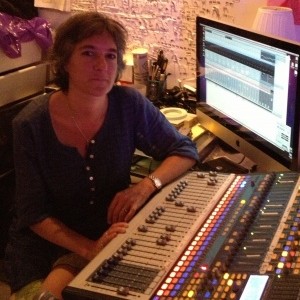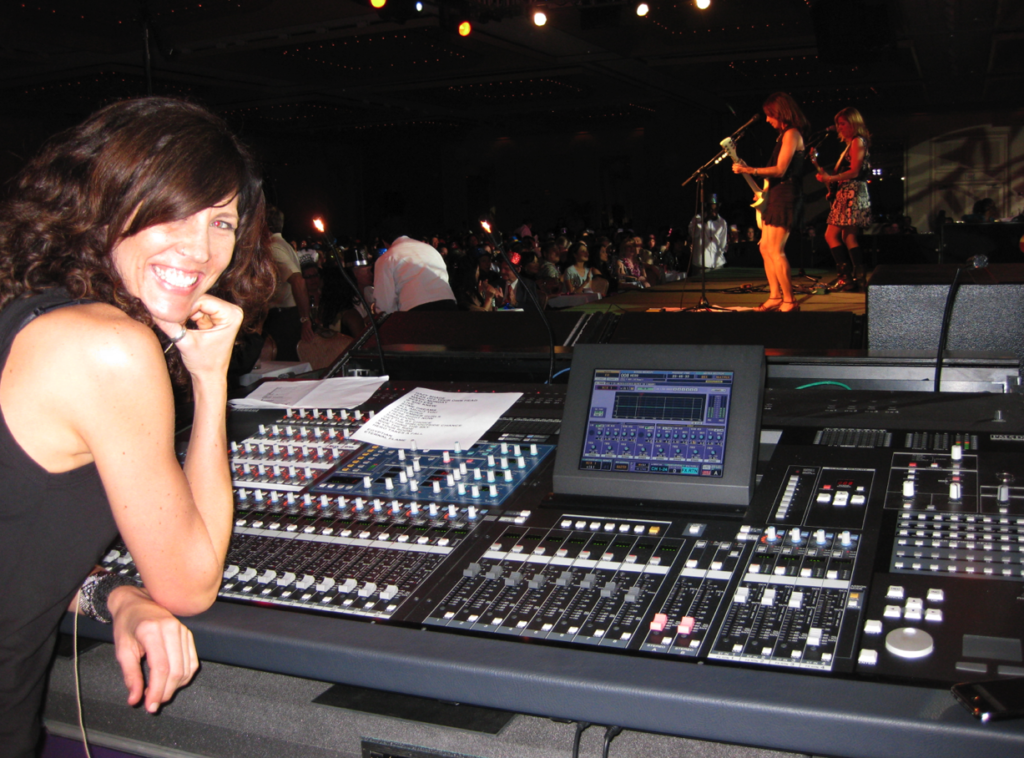 Claudia Engelhart has been working in live sound for the last 30 Years. Her parents were artists and musicians, and she grew up in Berkeley, CA, Claudia began her live sound career at the legendary jazz room Keystone Korner in San Francisco. The Keystone Korner hosted legendary jazz acts such as George Benson, Grover Washington, Bill Evens, Stan Getz, McCoy Tyner, Art Blakey and Miles Davis. The Keystone Korner left an enormous legacy of live recordings.
Claudia Engelhart has been working in live sound for the last 30 Years. Her parents were artists and musicians, and she grew up in Berkeley, CA, Claudia began her live sound career at the legendary jazz room Keystone Korner in San Francisco. The Keystone Korner hosted legendary jazz acts such as George Benson, Grover Washington, Bill Evens, Stan Getz, McCoy Tyner, Art Blakey and Miles Davis. The Keystone Korner left an enormous legacy of live recordings.
In 1983, Claudia moved to New York and started working at another legendary club CBGBS. By 1985, Claudia was touring full time and has been Bill Frisell’s FOH engineer since 1989. Claudia has toured with several renowned artists during her career including Ryuichi Sakamoto, Wayne Shorter, Herbie Hancock, Michael Brecker, David Byrne, Laurie Anderson, David Sylvian, John Patitucci, Dave Holland, Grover Washington Jr., John Scofield, Medeski Martin & Wood, John Zorn, The Kronos Quartet, Don Cherry, Cecil Taylor, Fred Frith, Eddie Palmieri, Willie Colon, Airto Moreira and Flora Purim, among others.
Growing up, Claudia was surrounded by working musicians and that perhaps has given her a deeper appreciation and understanding of music. The musical environment is natural to her, and she understands both music and musicians. Having studied the cello, piano, and voice for over ten years, Claudia always knew that she did not want to become a performer. “I played in the orchestra a little, but I wasn’t interested in that. I just loved the sound of the instruments, cello specifically, and how it felt to play”. Being surrounded by all those musicians, Claudia wanted “to find something of her own, which nobody else did.”
Through a family friend Airto Moreira, the Brazilian percussionist Claudia was exposed to the touring life. His band would stay with her family when they came to town on their West Coast tours. Claudia says “ there was something romantic about being on the road, seeing them all, hanging out with them, and going to the clubs to hear them play.” It was then that she knew she wanted to tour.
After graduation from high school, she traveled to Brazil for a year and coincidentally ended up staying with two live sound engineers. They had reel to reels of every live concert they had done, and Claudia believes they helped switch the light bulb on as it became clear she would pursue sound.
Luckily, she knew where to turn, her second home the Keystone Korner. Her parents were friends of Todd Barkan, the owner and attended many shows for free. Claudia and her sisters got to see many of the Jazz greats and often sat in the sound booth. She approached Milton Jeffries, the sound man, and he would give Claudia her first gig and become a teacher and mentor. He passed his knowledge down to Claudia teaching her to be patient, making sure she took her time to listen and then to make changes sonically. How important it is to talk to and get to know musicians, establishing the trust that is the foundation of live sound. Claudia says to this day she still heeds his advice “Just move slow, take your time, and record everything.”
From Keystone, she would make her way to New York and soon found herself mixing Audition Nights at CBGBs. Claudia says it was “a perfect place to learn. You could do anything, and it wouldn’t matter. It was crazy – like a garage band factory”. She also learned to work quickly with seven bands a night and 20 to 30 minute set times. CBGBS was at the height of the hardcore scene a complete 180 from the Jazz scene Claudia came from but says she did not meet any resistance to her gender and felt it often worked to her advantage. She was not alone either as both the head sound engineer and LD were women. Hilly Kristal, the owner, was very supportive, and Claudia says if there ever was a problem “ he would scare the shit out of people. Nobody would get in Hilly’s face. That’s for sure. He was a total puppy dog in real life. I think he was proud to have women on his crew”.
Claudia has fond memories of CBGBS, reminiscing that it was the best sounding club in New York, and bands would take the gig seriously. Bands could also get good sounding board tapes or 16 track recordings that they often used later. The sound system consisted of a 16 channel Soundcraft, an Apex 16 track recorder, and a large P.A. of JBL boxes. The system was designed and built by Norman Dunn. The best thing was that the mix position was in the middle of the room, where you could hear the P.A. Claudia says “CBGBS was a stepping stone – I think I might have been too young to realize how important it was. I wasn’t really focused on who would be there. In retrospect I was really lucky to cut my teeth in a room like that, I learned a lot”.
After CBGBs, she moved onto SOB’s, also known as Sounds of Brazil, a premier venue in NYC for world music. SOB’s hosted music Claudia loved, and she was able to connect with many talented musicians during her time there. It was also a challenging environment, with interesting instrument configurations and figuring out how to mic unusual instruments while achieving a rich and natural sound. Claudia says every day was a new experience and her launching pad for getting out on the road.
In 1989, the Knitting Factory called her in to mix Naked City, whom she had never heard of. The quintet included John Zorn, Fred Frith, Wayne Horvitz, Joey Baron, and Bill Frisell and Claudia spent a week mixing their improvised set of Thrash Metal, Free Jazz, Americana. Claudia says it was a blast and from then on John Zorn hired her for sound. She would tour with them through the early nineties and toured with Frisell’s, Frith and Horvitz’s bands. Since Naked City was the central band, there were never scheduling conflicts. She has been with Bill Frisell since.
Working with a musician or artist over several years has both pros and cons. Working with Frisell for over 25 years, Claudia finds it is important to work with other groups and styles of music that all bring fresh ideas and knowledge about sound. “There is always the danger of falling into a comfort zone when working with the same people all the time, that being said it does allow the ability to get really inside what is happening with the music.” Claudia elaborates “ It’s a deep place [to be] you become an integral part of their experience, and it is powerful for [both the artist and you]. Not everyone has that chance, in any workplace, to know and understand whom you work with at such an intense and intimate level. It’s a great thing.” Luckily Bill offers Claudia the chance to keep her mixing skills sharp as the band configurations change often. The most positive aspect is the bond Claudia and Bill have. They know and understand each other on a very deep level. Claudia explains that Bill knows he “can do anything [onstage] and he knows I’ll be right there to make sure it’s going to be heard. Ninety percent of it is about trust”.
Often interpreting an artist’s vision and translating it into the sound mix is a difficult task and Claudia spends a good deal of time talking with the artist to find out what they want to achieve sonically. When she was with David Byrne and his 55 piece orchestra, she found David to be incredibly articulate and able to convey how he wanted it to sound, working with her at FOH, making suggestions, she was able to get it closer to his vision. While on tour with Laurie Anderson she focused on the underlying sounds that might be overlooked or get lost in the mix. Establishing the trust for the artist to communicate with you is so vitally important. That trust allows room to experiment and get the best sound for that day, for that venue, that artist. While working with pianist Ryuichi Sakamoto on his solo piano tour, they experimented daily on the piano sound. Taking into account the venue sound, the piano, even the humidity. Microphone placement could change daily.
Sometimes less is more, as is the case with much of the music Claudia mixes.
The idea with Jazz and instrumental music is to let the band control their own dynamics as much as possible. In a Big Band situation, they have sections of instruments allowing them more control of their own volume as a whole. Smaller ensembles might be more dependent on the sound person. The term “reinforcement” really applies here – it’s about adding minimally what is missing – piano, acoustic bass, instruments that can get lost in the midst of the band, or follow a soloist to make sure they can be heard. There is a fine line to reinforcement and over amplifying that one has to be careful of. The acoustics in a venue play a considerable part in the performance; I try to use the room as much as possible to mix the band, and only add what I feel is missing. There is a lot left to interpretation, but in my experience less usually is more. A sound person can really make it difficult for a band to play if they are over amplifying them. The band no longer has control of their sound and dynamics. You really have to pay attention to the music, it is never a set it and leave it situation, even if you think you are not doing anything, small changes here and there can go a long way to making an acoustic band sound natural, amplified.
Monitors can play a huge role in how a musician plays their instrument. I work with a lot of bands that do not use monitors at all. They set up close together so they can hear each other naturally. If monitors are needed, usually they are very low volume, just enough to fill in what might be missing, not a whole band mix. Monitors can really determine how an acoustic band plays. If they are competing with loud sound onstage, they will have to play over that. It’s a very sensitive position to get a good monitor mix, and it can be very minimal. In this situation set it and leave it can apply. Letting the band
handle their own dynamics onstage is crucial to how they play. Remember though you always have to stay awake and pay attention to the band no matter how little mixing is going on in Monitor World! Things always change.
One Woman Crew! Claudia acts as road and production manager, FOH and Monitor engineer, and deals with backline equipment, lighting, and merch. Claudia says she pretty much “does everything except play onstage.” If she is on a tour that has a crew or road manager she is on vacation. She fell into road managing out of necessity as the acts did not have a budget for more than one crew person. She tries to do whatever is needed so the bands can focus on playing music. Her days are spent advancing shows, dealing with travel and transportation, driving the van, and finally getting to do what she loves mixing the show. The key to making this work is advance work, making sure all the bases are covered.
Even with all the advance work, there is often one variable that is out of her control; monitors and this can have a significant impact on the show. Claudia makes sure that the band and monitor engineer are introduced and that the band knows where monitor position is. She also takes time to explain to the ME what type of music they will be mixing and anything that is important to know about each musician. Communication is the key and so important. Sometimes the monitor mix is from the FOH console, and Claudia finds herself making several trips to the stage. She makes sure she eqs the wedges and determines the parameters she is dealing with. Is the sound on stage bright, dark, or mid-rangy, how will the sound of monitors affect the house mix, and getting the musicians confident for the show.
Claudia stresses that monitors are just as important as mixing FOH, and monitors often can make or break the performance. The ME needs to be on top of their game at all times, being sensitive to the needs of the band and FOH engineer, as well as taking into account the venue acoustics. When the ME knows what they are doing and giving their full attention to their job, Claudia knows she does not have to worry, and they will have a comfortable and fun day.
There are days though when the ME doesn’t understand the needs of the musicians, does not communicate or pay attention and forces Claudia into survival mode – getting the absolute minimum mixes going for the band so they can perform and get through the show. Hoping that the ME won’t change anything during the show. “SO MANY TIMES THE BAND HAS HEARD ME SAY, “DON’T TOUCH ANYTHING!”. SAD BUT TRUE”.
Claudia has many favorite venues but prefers the small theaters and intimate rooms where the audience is close to the band. The energy to audience brings to the band adds to the performance. She loves the festival circuit and has many favorites – Montreal-Newport-Umbria-San Francisco-London-Copenhagen Jazz Festivals. With sound technology continually changing, she does not get too attached to specific pieces of gear and finds that sound systems today are at such a high level that even the “bad” systems aren’t that bad. She does her best to make anything work, even if it’s not perfect. “I like the challenge! It’s a live performance – It’s Live.”
Claudia’s advice to young women starting out:
I think you have to be passionate about doing live sound. It’s a lifestyle that may not be for everyone. It takes endurance, patience, selflessness, and love of music and musicians. You have to be ready for the longest days, hard travel, no sleep, and hard work. But it is very rewarding and fun. Remember the show isn’t about you, it’s a team effort. Don’t be afraid to ask for help; it’s the best way to learn. Trust your instincts
More on Claudia



